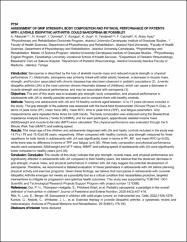| dc.contributor.author | Albayrak, Asya | |
| dc.contributor.author | Arman, N. | |
| dc.contributor.author | Dönmez, I. | |
| dc.contributor.author | Açıkgöz, Y. | |
| dc.contributor.author | Uçar, K. | |
| dc.contributor.author | Yekdaneh, A. | |
| dc.contributor.author | Çakmak, F. | |
| dc.contributor.author | Aktay Ayaz, N. | |
| dc.date.accessioned | 2024-09-18T12:06:01Z | |
| dc.date.available | 2024-09-18T12:06:01Z | |
| dc.date.issued | 2024 | en_US |
| dc.identifier.citation | Albayrak, A., Arman, N., Dönmez, I., Açıkgöz, Y., Uçar, K., Yekdaneh, A., Çakmak, F., Aktay Ayaz, N. Assessment of grip strength, body composition and physical performance of patients with Juvenile Idiopathic Arthritis: could sarcopenia be possible? Young Investigators Meeting 2024. | en_US |
| dc.identifier.uri | https://hdl.handle.net/20.500.12780/889 | |
| dc.description.abstract | Objectives: The aim of this study was to evaluate grip strength, body composition, and physical performance in
adolescents with JIA to identify possible sarcopenia and to compare them with healthy controls.
Methods: Twenty-one adolescents with JIA and 16 healthy controls aged between 12 to 17 years old were included in
the study. The grip strength of the patients was assessed with the hand-held dynamometer (Kinvent Physio K-Grip), in
terms of peak force (PF), mean force (MF), mean RFD, time to peak force (TPF), and fatigue parameters. Grip
measurements were repeated three times for both hands. The body composition was analyzed using the Bioelectrical
Impedance Analysis Device (Tanita SC240MA), and for each participant, appendicular skeletal muscle mass
(ASM)/weight and muscle-to-fat ratio (MTF) were calculated. The physical performance was evaluated through the 6
Minute Walk Test (6MWT) and walking speed.
Results: The mean age of the children and adolescents diagnosed with JIA and healty controls included in the study was
14.71±1.79 and 15.43±0.96 years, respectively. When compared with healthy controls, grip strength measured for three
repetitions for both hands in adolescents with JIA was significantly lower in terms of PF, MF, and mean RFD (p<0.05),
while there was no difference in terms of TPF and fatigue (p>0.05). When body composition and physical performance
results were compared, ASM/weight and MTF ratios, 6MWT and walking speed of adolescents with JIA were significantly
lower compared to healthy peers (p<0.05). | en_US |
| dc.language.iso | eng | en_US |
| dc.publisher | PReS | en_US |
| dc.rights | info:eu-repo/semantics/openAccess | en_US |
| dc.subject | Sarkopenia | en_US |
| dc.subject | Skeletal muscle | en_US |
| dc.subject | Performance physical | en_US |
| dc.title | Assessment of grip strength, body composition and physical performance of patients with Juvenile Idiopathic Arthritis: could sarcopenia be possible? | en_US |
| dc.type | conferenceObject | en_US |
| dc.contributor.department | İstanbul Kent Üniversitesi, Fakülteler, Sağlık Bilimleri Fakültesi, Fizyoterapi ve Rehabilitasyon Bölümü | en_US |
| dc.contributor.authorID | https://orcid.org/0000-0003-4648-9174 | en_US |
| dc.contributor.institutionauthor | Albayrak, Asya | |
| dc.relation.journal | Young Investigators Meeting 2024 | en_US |
| dc.relation.publicationcategory | Konferans Öğesi - Uluslararası - Kurum Öğretim Elemanı | en_US |


















